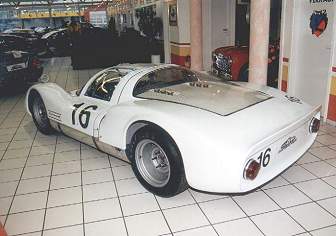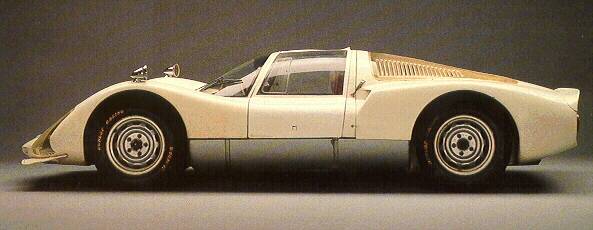
|
|

 
|
|
The 906 was built around an ultra-light tubular space-frame topped by a very streamlined body with an overall height of only 38.6 inches. The engine, turbend 190 degrees from its 911 position, was quite similar to the productionunit in basic design but significantly lighter, making extensive use of magnesium and aluminum alloys. With dual ignition, 10.3:1 compression, two triple-throat, Weber 46IDA carburators, and special manifolds and exhaust system, this 901/20 put out 220 bhp at 8000 rmp and 145 ft lbs maximum torque at 6000 rpm.
The first outing for the 906 was the 1966 Daytona 24 Hours, where a dark blue car finished sixth, beaten only by a factory team of fleet Ford GTs and a single Ferrari. The lead car at Sebring spunout, but 906s nailed fourth, sixth, and eigth. At Targa Florino that year they ended up 1-3-4-8. Ford's huge 7.0-liter GTs demonated LeMans, but the 2.0-liter Carrera were right behind, 4-5-6-7. Racing delelopments came thick and fast in the late Sixties; those from Porsche were mostly logical evolutions. Thus, the 904's suspension and brakes went into the 906, whose frame was lightened and modified for the 910. Next came the 907, which started out as a more aerodynamic 910, with the same six- and eight-cylinder engine and somewhat smoother bodywork, again in K (Kurzheck, short-tail) and L (Langheck, long-tail) guises. The next step was the 908, basically a 907 with a new and simpler 3.0-liter flat eight. |
|
General |
Engine |
Performance |
|
Year : 1965 Make and Model : Porsche 906 Curb Weight : 617 kg Layout : -- Transmission : 4-Speed Manual |
Configuration : Flat-6 Displacement : 1991 cc Power : 220 bhp (--kw) @ --rpm Torque : --nm @ --rpm Redline : --rpm |
Top speed : 270 kmh (168 mph) Acc. 0-100 kmh : --s Acc. 0-160 kmh : --s Acceleration 0-¼ mile : --s Lateral Acc. : --g |
|
|
Site created by Alin Sãndulache |
|